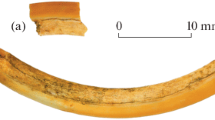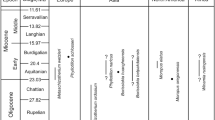Abstract
A lower jaw fragment of the mole Mongoloscapter zhegalloi Lopatin, 2002 (Talpidae, Talpinae) from the Late Oligocene Tsakhir-Ula locality (Mongolia, Ömnögovi Aimag) is described. This is the second record of Mongoloscapter. This genus is characterized by a lower molar structure that suggests that it should be assigned to the tribe Scaptonychini.


Similar content being viewed by others
REFERENCES
Bannikova, A.A., Zemlemerova, E.D., Lebedev, V.S., et al., Phylogenetic position the Gansu mole Scapanulus oweni Thomas, 1912 (Mammalia, Talpidae) and relationships of highly specialized underground talpid groups, Dokl. Akad. Nauk, 2015, vol. 464, no. 2, pp. 238–242.
Bohlin, B., The fossil mammals from the Tertiary deposit of Taben-Buluk, western Kansu: Part 1. Insectivora and Lagomorpha, Palaeontol. Sin. Nov. Ser. C, 1942, no. 8a, pp. 1–113.
Bohlin, B., The fossil mammals from the Tertiary deposit of Taben-Buluk, western Kansu: Part 2. Simplicidentata, Carnivora, Artiodactyla, Perissodactyla and Primates, Palaeontol. Sin. Nov. Ser. C, 1946, no. 8b, pp. 1–259.
Daxner-Höck, G., Badamgarav, D., Barsbold, R., et al., Oligocene stratigraphy across the Eocene and Miocene boundaries in the Valley of Lakes (Mongolia), Palaeobiodiv. Palaeoenviron., 2017, vol. 97, no. 1, pp. 111–218.
Freeman, P.W., Redescription and comparison of a highly fossorial mole, Domninoides mimicus (Insectivora, Talpidae), from the Clarendonian, Am. Mus. Novit., 1979, no. 2667, pp. 1–16.
Gureev, A.A., Fauna SSSR. Mlekopitayushchie (Fauna of the USSR: Mammals), vol. 4, no. 2: Nasekomoyadnye (Mammalia, Insectivora). Ezhi, kroty i zemleroiki (Erinaceidae, Talpidae, Soricidae) (Insectivores (Mammalia, Insectivora): Hedgehogs, Moles, and Shrews (Erinaceidae, Talpidae, Soricidae), Leningrad: Nauka, 1979.
He, K., Shinohara, A., Campbell, K.L., et al., Talpid mole phylogeny unites shrew moles and illuminates overlooked cryptic species diversity, Mol. Biol. Evol., 2017, vol. 34, no. 1, pp. 78–87.
Hooker, J.J., Skeletal adaptations and phylogeny of the oldest mole Eotalpa (Talpidae, Lipotyphla, Mammalia) from the UK Eocene: The beginning of fossoriality in moles, Palaeontology, 2016, vol. 59, pp. 195–216.
Hugueney, M., Les talpidés (Mammalia, Insectivora) de Coderet-Bransat (Allier) et l'évolution de cette famille au cours de l’Oligocène supérieur et du Miocène inférieur d’Europe, Docum. Lab. Géol. Fac. Sci. Lyon, 1972, no. 50, pp. 1–81.
Hugueney, M. and Maridet, O., Evolution of Oligo-Miocene talpids (Mammalia, Talpidae) in Europe: Focus on the genera Myxomygale and Percymygale n. gen., Hist. Biol., 2018, vol. 30, nos. 1–2, pp. 267–275.
Hutchison, J.H., Notes on type specimens of European Miocene Talpidae and a tentative classification of Old World Tertiary Talpidae (Insectivora: Mammalia), Geobios, 1974, vol. 7, no. 3, pp. 211–256.
Kawada, S.I., Li, S., Wang, Y.X., et al., Karyotype evolution of shrew moles (Soricomorpha: Talpidae), J. Mammal., 2008, vol. 89, no. 6, pp. 1428–1434.
Lopatin, A.V., An Oligocene mole (Talpidae, Insectivora, Mammalia) from Mongolia, Paleontol. Zh., 2002, no. 5, pp. 89–92.
McKenna, M.C. and Bell, S.K., Classification of Mammals above the Species Level, New York: Columbia Univ. Press, 1997.
Meng, J. and McKenna, M.C., Faunal turnovers of Palaeogene mammals from the Mongolian Plateau, Nature, 1998, vol. 394, no. 6691, pp. 364–367.
Rzebik-Kowalska, B. and Lungu, A., Insectivore mammals from the Late Miocene of the Republic of Moldova, Acta Zool. Cracov., 2009, vol. 52A, nos. 1–2, pp. 11–60.
Sansalone, G., Kotsakis, T., Schwermann, A.H., Van den Hoek Ostende, L.W., and Piras, P., When moles became diggers: Tegulariscaptor gen. nov., from the Early Oligocene of south Germany, and the evolution of talpid fossoriality, J. Syst. Palaeontol., 2017, vol. 16, no. 8, pp. 1–13.
Schwermann, A.H. and Martin, T., A partial skeleton of Geotrypus antiquus (Talpidae, Mammalia) from the Late Oligocene of the Enspel fossillagerstätte in Germany, Paläontol. Z., 2012, vol. 86, no. 4, pp. 409–439.
Schwermann, A.H. and Thompson, R.S., Extraordinarily preserved talpids (Mammalia, Lipotyphla) and the evolution of fossoriality, J. Vertebr. Paleontol., 2015, vol. 35, no. 4. e934828.
Shinohara, A., Suzuki, H., Tsuchiya, K., et al., Evolution and biogeography of talpid moles from continental East Asia and the Japanese Islands inferred from mitochondrial and nuclear gene sequences, Zool. Sci., 2004, vol. 21, no. 12, pp. 1177–1185.
Skoczeń, S., Scaptonychini Van Valen, 1967, Urotrichini and Scalopini Dobson, 1883 (Insectivora, Mammalia) in the Pliocene and Pleistocene of Poland, Acta Zool. Cracov., 1976, vol. 24, no. 9, pp. 411–448.
Storch, G. and Qiu, Zh., The Neogene mammalian faunas of Ertemte and Harr Obo in Inner Mongolia (Nei Mongol), China. 2. Moles—Insectivora: Talpidae, Senckenb. Lethaea, 1983, vol. 64, nos. 2/4, pp. 89–127.
Van Valen, L., New Paleocene insectivores and insectivore classification, Bull. Am. Mus. Natur. Hist., 1967, vol. 135, no. 5, pp. 217–284.
Whidden, H.P., Comparative myology of moles and the phylogeny of the Talpidae (Mammalia, Lipotyphla), Am. Mus. Novit., 2000, no. 3294, pp. 1–53.
Wilson, R.W., Early Miocene rodents and insectivores from North Eastern Colorado, Paleontol. Contrib. Univ. Kansas. Vertebr., 1960, no. 7, pp. 1–92.
Zapfe, H., Die Fauna der miozänen Spaltenfüllung von Neudorf a. d. March (CSR.) Insectivora, Sitzungsber. Österr. Akad. Wiss. Math.-Naturwiss. Kl. I, 1951, vol. 160, no. 5, pp. 449–480.
Ziegler, R., Talpidae (Insectivora, Mammalia) aus dem Oberoligozän und Untermiozän Süddeutschlands, Stuttgart. Beitr. Naturk. Ser. B, 1990, no. 167, pp. 1–81.
Ziegler, R., Moles (Talpidae) from the late Middle Miocene of south Germany, Acta Palaeontol. Polon., 2003, vol. 48, no. 4, pp. 617–648.
Ziegler, R., Moles (Talpidae, Mammalia) from Early Oligocene karstic fissure fillings in south Germany, Geobios, 2012, vol. 45, pp. 501–513.
Ziegler, R., Dahlmann, T., and Storch, G., Oligocene–Miocene vertebrates from the Valley of Lakes (central Mongolia): Morphology, phylogenetic and stratigraphic implications: 4. Marsupialia, Erinaceomorpha and Soricomorpha (Mammalia), Ann. Naturhist. Mus. Wien, 2007, vol. 108A, pp. 53–164.
ACKNOWLEDGMENTS
This study was supported in part by the Program of the Presidium of the Russian Academy of Sciences “Evolution of the Organic World: Role and Effect of Planetary Processes.”
Author information
Authors and Affiliations
Corresponding author
Additional information
Translated by G. Rautian
Rights and permissions
About this article
Cite this article
Lopatin, A.V. A New Record of Mongoloscapter (Talpidae, Lipotyphla, Mammalia) from the Oligocene of Mongolia. Paleontol. J. 52, 677–681 (2018). https://doi.org/10.1134/S0031030118060072
Received:
Published:
Issue Date:
DOI: https://doi.org/10.1134/S0031030118060072




